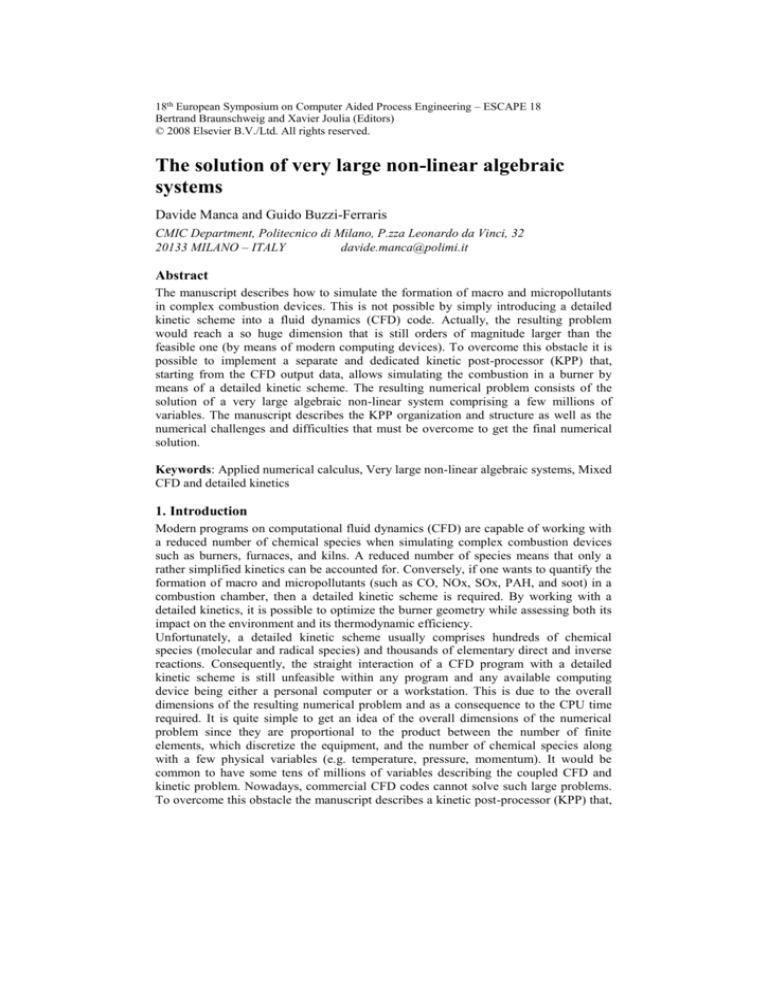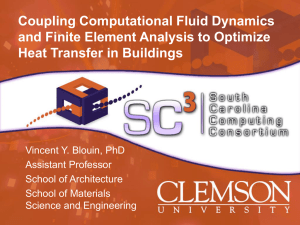
18th European Symposium on Computer Aided Process Engineering – ESCAPE 18
Bertrand Braunschweig and Xavier Joulia (Editors)
© 2008 Elsevier B.V./Ltd. All rights reserved.
The solution of very large non-linear algebraic
systems
Davide Manca and Guido Buzzi-Ferraris
CMIC Department, Politecnico di Milano, P.zza Leonardo da Vinci, 32
20133 MILANO – ITALY
davide.manca@polimi.it
Abstract
The manuscript describes how to simulate the formation of macro and micropollutants
in complex combustion devices. This is not possible by simply introducing a detailed
kinetic scheme into a fluid dynamics (CFD) code. Actually, the resulting problem
would reach a so huge dimension that is still orders of magnitude larger than the
feasible one (by means of modern computing devices). To overcome this obstacle it is
possible to implement a separate and dedicated kinetic post-processor (KPP) that,
starting from the CFD output data, allows simulating the combustion in a burner by
means of a detailed kinetic scheme. The resulting numerical problem consists of the
solution of a very large algebraic non-linear system comprising a few millions of
variables. The manuscript describes the KPP organization and structure as well as the
numerical challenges and difficulties that must be overcome to get the final numerical
solution.
Keywords: Applied numerical calculus, Very large non-linear algebraic systems, Mixed
CFD and detailed kinetics
1. Introduction
Modern programs on computational fluid dynamics (CFD) are capable of working with
a reduced number of chemical species when simulating complex combustion devices
such as burners, furnaces, and kilns. A reduced number of species means that only a
rather simplified kinetics can be accounted for. Conversely, if one wants to quantify the
formation of macro and micropollutants (such as CO, NOx, SOx, PAH, and soot) in a
combustion chamber, then a detailed kinetic scheme is required. By working with a
detailed kinetics, it is possible to optimize the burner geometry while assessing both its
impact on the environment and its thermodynamic efficiency.
Unfortunately, a detailed kinetic scheme usually comprises hundreds of chemical
species (molecular and radical species) and thousands of elementary direct and inverse
reactions. Consequently, the straight interaction of a CFD program with a detailed
kinetic scheme is still unfeasible within any program and any available computing
device being either a personal computer or a workstation. This is due to the overall
dimensions of the resulting numerical problem and as a consequence to the CPU time
required. It is quite simple to get an idea of the overall dimensions of the numerical
problem since they are proportional to the product between the number of finite
elements, which discretize the equipment, and the number of chemical species along
with a few physical variables (e.g. temperature, pressure, momentum). It would be
common to have some tens of millions of variables describing the coupled CFD and
kinetic problem. Nowadays, commercial CFD codes cannot solve such large problems.
To overcome this obstacle the manuscript describes a kinetic post-processor (KPP) that,
2
D. Manca and G. Buzzi-Ferraris
starting with the CFD output data produced by a well known commercial program,
simulates the combustion in a burner by means of a detailed kinetic scheme.
The numerical case-study is based on the combustion of syngas, which is a mixture of
hydrogen and carbon monoxide that can be obtained from natural gas, coal, petroleum,
biomass and organic waste. Methanol synthesis and Fischer-Tropsch synthesis remain
the largest use of syngas. Recently, syngas has become also a significant source of
environmentally clean fuels and this is why an accurate study of the structure of syngas
flames with a special attention to pollutant formation is of paramount interest. The
design of syngas-fuelled combustion systems can utilize CFD to optimize the energetic
efficiency. However, combustion systems have to respect increasingly stringent
pollutant emission limits. Therefore, pollutant formation is one of the focuses of new
burner designs. This explains the increasing demand for computational tools capable of
characterizing the combustion systems also in terms of pollutant species.
2. The KPP structure
As reported in Cuoci et al. (2007), the CFD simulation of the syngas burner is done by a
commercial CFD code that integrates the Navier-Stokes equations with a very
simplified kinetic model, which allows keeping rather low the overall number of
unknowns. Actually, even with new generation computers, the direct coupling of
detailed kinetics and complex CFD remains a very difficult and expensive task,
especially when considering the usual number of grid points used in industrial
applications. When referring to 105-106 grid cells (finite elements) and 100-200 reacting
species, the dimensions of the overall system of mass balance equations become higher
than 107-108.
The general concept of “reactor network analysis” has already been employed by
various authors to post-process CFD results and evaluate the formation of pollutants,
using detailed kinetic mechanisms for various applications by utilizing a different level
of description and various numerical methodologies (Falcitelli et al., 2002a, 2002b;
Skjøth-Rasmussen et al., 2004; Novosselov et al., 2006).
Figure 1: Predicted CO and NOx emissions from the burner as a function of the number of
lumping reactors.
The KPP uses as input data the temperature and flow fields predicted by the CFD code
and solves the overall system of mass balance equations in a complex reaction network
with detailed kinetic schemes. Two major simplifications characterize the KPP and
The solution of very large non-linear algebraic systems
3
make the numerical model feasible and advantageous over the direct coupling of a
detailed kinetic scheme with the CFD code. The first feature is the transformation of the
original computational grid into a reactor network. Knowledge of the thermo fluid
dynamic field, as evaluated by the CFD code, allows several adjacent and very similar
cells to be lumped into single equivalent reactors. A second way of making the
numerical computations more stable and viable is defining an average and fixed
temperature inside the different reactors.
The solution of the CFD code provides the detailed flow, composition and temperature
fields, and this information allows identifying both critical and non-critical zones in the
overall reacting system. The description detail can be reduced in several regions without
affecting significantly the results. The grouping or clustering of several kinetically
similar cells into a single lumped reactor reduces the dimensions of the overall system
(see also Figure 1). The fixed temperature inside these reactors reduces the extreme
non-linearity of the algebraic system, which is mainly related to the reaction rates and to
the coupling between mass and energy balances.
The temperature, composition, and fluid dynamic fields obtained through the CFD code
allow identifying the critical zones in the combustion chamber, i.e. the specific regions
where large temperature and/or composition gradients are present. It is convenient to
retain the original detail of the CFD grid in these zones. However, large volumes of the
system are less critical from a kinetic point of view, e.g. cold and/or non-reactive zones.
This fact suggests that the detail of the grid can be locally reduced by clustering and
combining several cells into a single equivalent reactor. Of course, the lumped cell
volume is simply the sum of the volumes of the grouped cells. The original grid size is
thus transformed into a network of several reactors where the links between the
different reactors simply combine and reflect the original flow field as evaluated by the
CFD code. This allows reducing the total number of equivalent reactors and it makes
feasible handling the mass balance equations by using detailed kinetic schemes with a
large number of species. The original 105-106 cells can be conveniently grouped into
103-104 equivalent reactors thus maintaining a more than reasonable description of the
flame structure and the reacting system.
A mesh-coarsening algorithm was designed so to prevent possible dangerous situations
such as the creation of geometrical irregularities and/or non-smooth transition between
zones with very different volumes. The interlinking flows are evaluated according to the
convective rates exchanged between the cells belonging to the different reactors. The
mass diffusion coefficients for the coarse mesh are calculated in agreement with the
original diffusive flow rates. Temperature and initial compositions in the equivalent
reactors are the volume-averaged values of the combined cells. Different clustering
levels are sequentially adopted and calculations are iteratively performed by increasing
the number of cells up to the final convergence, i.e. up to the point where a further
increase in the reactor network dimensions does not change significantly the predicted
profiles.
3. The numerical solution of large algebraic non-linear systems
The burner model (Cuoci et al., 2007) simulates the steady state behaviour of the
equipment. Moreover, each cell either lumped or not is assumed to be perfectly mixed.
These assumptions drive to the solution of a system of non-linear algebraic equations.
CFD results are used to define the overall system by describing the mass balance
equations of all the chemical species involved in the detailed kinetic scheme as well as
providing the initial composition guess. For all the equivalent reactors, the steady-state
4
D. Manca and G. Buzzi-Ferraris
mass balance of each species ( wi ) accounts for convection, diffusion and chemical
reaction terms (Frassoldati et al., 2007).
As already mentioned, the dimension of the overall system, which is conveniently
reduced using the cells lumping procedure, becomes:
nV ariables = nLumpedCells ´ nSpecies .
Figure 2 shows a typical Boolean structure of the whole matrix system for a simple
structured 2D grid as well as the structure of a single block.
Figure 2: Top left: Boolean structure of the Jacobian matrix of the non-linear system for a simple
structured 2D computational mesh. Top right: zoom of the diagonal region. Bottom center: zoom
of the single block structure (square in Top right panel) describing the chemical species presence.
The global Newton or modified Newton methods are not robust enough to solve the
system using the CFD results as a first-guess. Therefore, it is convenient to approach a
better estimate of the solution by iteratively solving the sequence of individual reactors
with successive substitutions (helped by suitable acceleration techniques), which have
the advantage of being inexpensive in terms of CPU time and take the whole system
closer to the solution. Each reactor is solved by using a local Newton method (i.e. a
conventional Newton method applied to the single reactor) with the possible integration
of a “false transient” by means of an ordinary differential equation (ODE) system to
improve the initial guess while approaching the solution. Only when the residuals of all
the equations reach sufficiently low values, can a modified global Newton method be
The solution of very large non-linear algebraic systems
5
applied to the whole system (see also Buzzi-Ferraris and Manca, 2006). Otherwise, the
previous procedure is iterated to further improve the residuals. At a very basic level, the
Newton method involves the solution of a linear system of the Jacobian coefficient
matrix. In order to increase the computational efficiency, special attention is devoted to
the evaluation of the sparse Jacobian coefficients. The derivatives of rate equations are
evaluated analytically rather than numerically. The bottleneck of this very large system
consists of both memory allocation and CPU time when a Gauss factorization method is
applied to the whole system. Thus, Gauss factorization is used only for the main
diagonal square blocks, while an iterative method is applied to the off-diagonal terms
(Manca et al., 1995). This approach saves on the memory allocation and makes the
solution of the overall system viable. Also in this case, if the global Newton method
does not converge, a “false transient” method is applied to ensure a better approach to
the solution of the whole system.
The global Newton method not only increases efficiency but also ensures the complete
convergence to the solution. In fact, it is necessary to speed up the convergence
procedure, which is very slow in case of direct substitutions. Moreover, high attention is
required in the convergence check. In fact, in case of direct substitutions, convergence is
generally controlled by the typical normalized error sum of squares:
2
nV ariables æ ( n )
ö
w - wi(n - 1) ÷
÷
err = å ççç i
(1)
÷
÷
wi(n )
è
ø
i= 1
where wi are the mass fractions and suffix n refers to the iteration number. The
request for err to be less than a user-defined precision e1 is a necessary but not
sufficient condition. Actually, when working with direct substitutions, a small err
value may just be the result of convergence failure rather than the approach to the
numerical solution. Conversely, when a Newton method is adopted, if err < e1 then the
method is converging to the solution within the required precision (see also BuzziFerraris and Manca, 2006). Our numerical procedure checks also for the residuals of all
the equations of the global non-linear system to be less than a user-defined precision e2 .
By doing so, the effective convergence to the solution of the non-linear system is
extensively and consistently controlled.
The KPP numerical framework is shown schematically in Figure 3. The KPP takes
about 20 hours of CPU time on a Pentium IV @ 2.8 GHz with 2 GB of RAM to solve
the overall problem that at the maximum extension (depending on the adaptive cells
lumping procedure) reaches the significant dimension of 34,632 reactors with a detailed
scheme of 106 species and 1,536 elementary reactions. Therefore, a maximum number
of 3,670,992 algebraic non-linear equations are solved by the aforementioned
procedure. The KPP is written in C++ and uses the object-oriented classes of the
BzzMath library (Manca and Buzzi-Ferraris, 2005). The KPP output results are
extensively discussed in Frassoldati et al. (2005) and in Cuoci et al. (2007).
References
Buzzi Ferraris G., D. Manca, “Large Scale Algebraic Systems”, in Computer Aided Process and
Product Engineering, Wiley-Vch, Weinheim, 1, 15-34, (2006)
Cuoci A., A. Frassoldati, G. Buzzi Ferraris, T. Faravelli, E. Ranzi, “The ignition, combustion and
flame structure of carbon monoxide/hydrogen mixtures. Note 2: Fluid dynamics and kinetic
aspects of syngas combustion”, Int. J. of Hydrogen Energy 32, 3486 – 3500, 2007.
6
D. Manca and G. Buzzi-Ferraris
Falcitelli M., S. Pasini, and L. Tognotti, “An algorithm for extracting chemical reactor network
models from CFD simulation of industrial combustion systems”, Combustion Science and
Technology, 174, 22, 2002a.
Falcitelli M., S. Pasini, N. Rossi, and L. Tognotti, “CFD+reactor network analysis: an integrated
methodology for the modelling and optimisation of industrial systems for energy saving and
pollution reduction”, Applied Thermal Engineering, 22, 971, 2002b.
Frassoldati A., G. Buzzi-Ferraris, T. Faravelli, and E. Ranzi, “Post-Processing of CFD
simulations with detailed kinetics”, 28th Meeting of Italian Section of The Combustion
Institute, Naples, Italy, 2005.
Frassoldati A., T. Faravelli, E. Ranzi, “Ignition, Combustion and Flame Structure of Carbon
Monoxide/Hydrogen. Mixtures. Note 1: Detailed Kinetic Modeling of Syngas Combustion
also in Presence of Nitrogen Compounds”, Int. J. of Hydrogen Energy, 32, 3471-3485, 2007.
Manca D., T. Faravelli, G. Pennati, G. Buzzi Ferraris, E. Ranzi, “Numerical Integration of Large
Kinetic Systems”, ICheaP-2, ERIS, Milan, 115-121, 1995
Manca D., G. Buzzi Ferraris, “Bzzmath: an Object Oriented Library for Applied Numerical
Analysis”, ACS, Reed Business Information, Milan, 7, 209-218, 2005
Novosselov I.V., P. C. Malte, S. Yuan, R. Srinivasan, and J. C. Y. Lee, “Chemical reactor
network application to emissions prediction for industrial DLE Gas Turbine”, Proceedings of
GT2006 ASME Turbo Expo 2006, Barcelona, Spain, 2006.
Skjøth-Rasmussen M.S., O. Holm-Christensen, M. Østberg, T.S. Christensen, T. Johannessen, A.
Jensen, and P. Glarborg, “Post-processing of detailed chemical kinetic mechanism onto CFD
simulations”, Computers and Chemical Engineering, 28, 2351-2361, 2004.
CFD results
Adaptive cells lumping
criteria
Partial first guess solution +
T, P, v profiles
Local solution in each reactor of the network
Newton’s method
OK
Time stepping ODE solver
NO
YES
NO
Low residuals for every reactor?
YES
Global solution for all the reactors
Newton’s method
OK
Time stepping ODE solver
NO
YES
NO
Low residuals in
all the equations?
YES
FINAL
SOLUTION
Figure 3: Schematic representation of the numerical procedure for the solution of large NLS.








